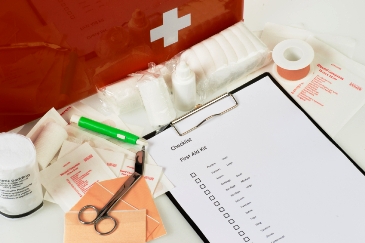By Dr. Paul Auerbach
No youth sports team or competition should be without a first aid kit designed to treat the most common injuries and illnesses that might be encountered.
Match the contents to the sport: The type of first aid that may be required varies by sport. Because bruises, abrasions, and sprained ankles are more common in baseball, a baseball team’s first aid kit, for instance, needs to be stocked with cold packs, elastic bandages, and Band-Aids, while a track team’s kit needs to have plenty of supplies to treat blisters, abrasions, pulled muscles, and sprains. If your team is going to be in the sun, carry sunscreen; the cross-country coach needs to carry an allergy kit to manage bee stings.
Stock a realistic quantity: Be prepared to treat more than one child at an event. For younger children, remember to stock pediatric doses (in liquid form, if necessary).
Ensure ready access: First aid supplies should be placed where they are readily accessible, and marked clearly to allow rapid identification. Use Ziploc-type bags within the kit for extra materials and to sort your supplies. For instance, it is helpful to partition supplies into modules “for wound care,” “for an allergic reaction,” and so forth.
Protect against damage: Carry supplies in a watertight container designed to withstand years of rough handling and extremes in temperature, such as a plastic (Pelican case or Otter Box) or metal container equipped with a rubber O-ring gasket for a tight, waterproof seal.
First-Aid Kit Contents
Listed below are what a sports first aid should contain. Go through this list carefully, and make a decision to include or exclude these items from your medical kit. Have a medical professional teach you how to take care of your players, so that when the time comes, you will know how to apply a Steri-Strip to close a wound, mold a Sam Splint to support a sprained wrist, or use a pocket mask to perform rescue breathing.
General Supplies
- First Aid Manual or Emergency/CPR flashcards
- Safety pins
- Paramedic or EMT shears (scissors, but without pointed ends)
- Bandage scissors
- Splinter forceps (tweezers)
- Standard oral thermometer: digital, mercury, or alcohol
- Wooden tongue depressors (“tongue blades”)
- Waterproof flashlight (such as Pelican MityLite*) or headlamp (and spare batteries)
- CPR mouth barrier or pocket mask (such as a Microshield X-L Mouth Barrier*)
- Sterile (hypoallergenic or latex) surgical gloves (at least 2 pair); if you are allergic to latex, bring nonlatex, synthetic, nonpermeable gloves;
- Instant chemical cold pack(s)1
- Ziploc* bags (to hold ice for ice packs)
- Rescue blanket
- Cell phone
- Medical release forms
- List of emergency phone numbers (paramedics, hospital emergency room)
- Bottled water (for wound care)
Wound Care-Preparations and Dressings
- Elastic bandages (Band-Aid* or Coverlet*) in assorted sizes (strip, knuckle, and broad); cloth with adhesive is preferable
- Adhesive strips for wound closure (Steri-Strip* or Cover-Strip II*), assorted sizes, reinforced [plain or impregnated with an antimicrobial] or elastic
- 3″x 3″ or 4″ x 4″ sterile gauze pads (packets of 2 to 5) (such as Nu-Gauze* highly absorbent)
- 5″ x 9″ or 8″ x 10″ sterile gauze (“trauma”) pads (packets of 2 to 5)
- Nonstick sterile bandages (Telfa*), assorted sizes (used to cover abrasions)
- 1″, 2″, 3″, and 4″ rolled conforming gauze (C-wrap* or Elastomull*)
- 1″ x 10 yds (9.1 m) rolled cloth adhesive tape
- 1″ x 10 yds (9.1 m) rolled paper or silk (hypoallergenic) adhesive tape
- 1″ x 10 yds (9.1 m) rolled waterproof adhesive tape
- Safe Skin by Kimberly Clark* (4 1/8 in x 3 3/8 in)
- Moleskin Plus* (4 1/8 in x 3 3/8 in)
- Spenco 2nd Skin* (1.5″ x 2″, 3″ x 4″, 3″ x 6.5″) and Spenco* Adhesive Knit Bandage (3″ x 5″)
- Tegaderm* transparent wound dressing (also comes in combination with a Steri-Strip in a Wound Closure System)
- Liquid soap
- Sterile disposable surgical scrub brush
- Sterile cotton-tipped swabs or applicators, 2 per package
- Tincture of benzoin, bottle or swabsticks
- Povidone iodine 10% solution (Betadine), 1 oz bottle or swabsticks
- Antiseptic towelettes
Splinting and Sling Material
- Cravat cloth (triangular bandage)
- 2″, 3″, and 4″ elastic wrap (Ace*)
- 4″ x 36″ SAM Splints (2)
- Aluminum finger splints
Eye Medications and Dressings
- Prepackaged individual sterile oval eye pads
- Prepackaged eye bandages (Coverlet Eye Occlusor*)
- Metal or plastic eye shield
- Sterile eyewash, 1 oz (30 ml)
- Contact lens remover
Dental Supplies
Topical Skin Preparations
- Bacitracin, mupirocin, or bacitracin-neomycin polymyxin B sulphate ointment
- Insect repellent containing DEET
- Sunscreen lotion or cream (SPF 15 or 30)
- Lip balm or sunscreen
- Sunblock
Nonprescription Medications
- Ibuprofen, 200 mg tablets
- Acetaminophen, 325 mg tablets
- Antacid
- Decongestant (such as oxymetazoline) nasal spray (to treat a nosebleed that doesn’t respond to simple pressure)
- Glutose (liquid glucose) paste tube (to treat a hypoglycemic – low blood sugar – reaction). In a pinch, sugar packets will do.
Allergy Kit
- EpiPen Auto-Injector [0.3 mg] and EpiPen Jr. Auto-Injector [0.15 mg]) or allergy kit with injectable epinephrine (Ana-Kit)
- Diphenhydramine (Benadryl), 25 mg capsules
Other
- Other equipment and supplies may be available at the venue, but are not usually transported with a youth athletic team, unless there are special circumstances. These include such items as large splints to accommodate major fractures (such as of the thigh), stretcher, and AED (automated external defibrillator) [2].
*Brand names are shown to indicate representative products, not to indicate that these are the only products that may be used. Quality, availability, cost, and preference will influence which specific products you choose.






